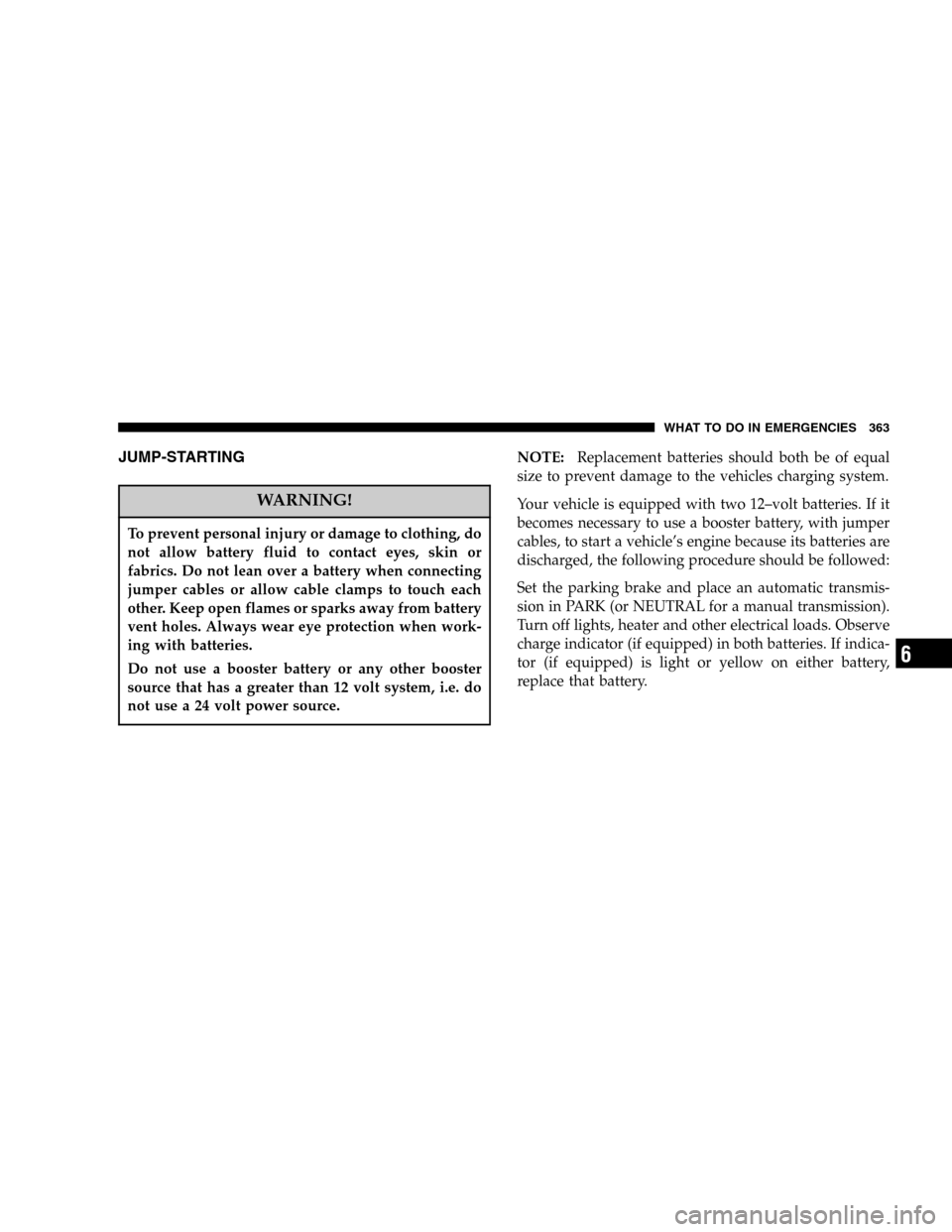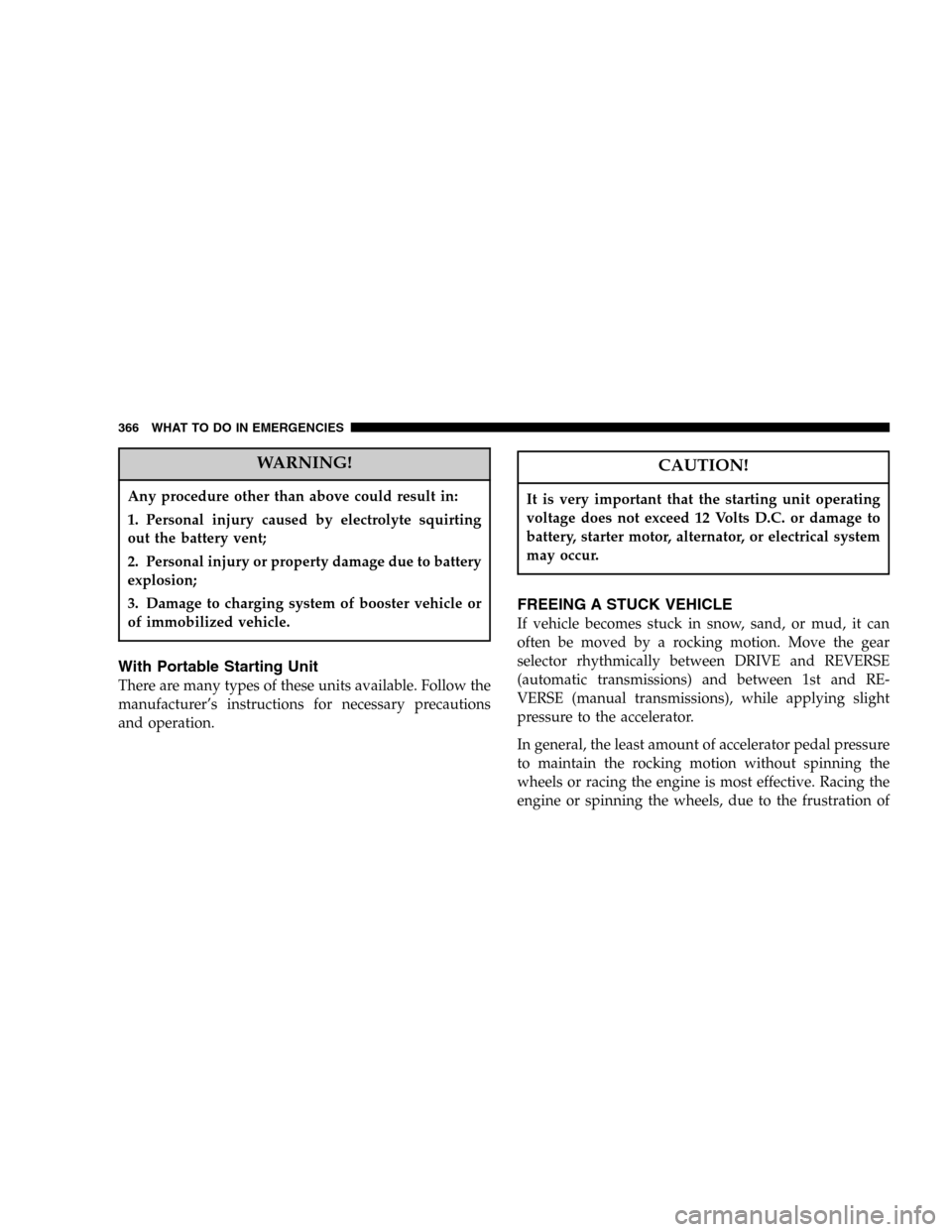Page 354 of 493
•Block both the front and rear
of the wheel diagonally oppo-
site the jacking position. For
example, if the right front
wheel is being changed, block
the left rear wheel.
•Passengers should not remain in the vehicle when the
vehicle is being jacked.
Instructions
WARNING!
Carefully follow these tire changing warnings to help
prevent personal injury or damage to your vehicle:
•Always park on a firm, level surface as far from the
edge of the roadway as possible before raising the
vehicle.
•Block the wheel diagonally opposite the wheel to be
raised.
•Apply the parking brake firmly before jacking.
•Never start the engine with the vehicle on a jack.
•Do not let anyone sit in the vehicle when it is on a
jack.
•Do not get under the vehicle when it is on a jack.
•Only use the jack in the positions indicated.
•If working on or near a roadway, be extremely
careful of motor traffic.
354 WHAT TO DO IN EMERGENCIES
Page 363 of 493

JUMP-STARTING
WARNING!
To prevent personal injury or damage to clothing, do
not allow battery fluid to contact eyes, skin or
fabrics. Do not lean over a battery when connecting
jumper cables or allow cable clamps to touch each
other. Keep open flames or sparks away from battery
vent holes. Always wear eye protection when work-
ing with batteries.
Do not use a booster battery or any other booster
source that has a greater than 12 volt system, i.e. do
not use a 24 volt power source.
NOTE:Replacement batteries should both be of equal
size to prevent damage to the vehicles charging system.
Your vehicle is equipped with two 12–volt batteries. If it
becomes necessary to use a booster battery, with jumper
cables, to start a vehicle’s engine because its batteries are
discharged, the following procedure should be followed:
Set the parking brake and place an automatic transmis-
sion in PARK (or NEUTRAL for a manual transmission).
Turn off lights, heater and other electrical loads. Observe
charge indicator (if equipped) in both batteries. If indica-
tor (if equipped) is light or yellow on either battery,
replace that battery.
WHAT TO DO IN EMERGENCIES 363
6
Page 365 of 493

2. Connect one end of the other jumper cable to negative
(-) post of booster battery. Connect the other end of the
jumper cable to a good ground on the engine block of the
vehicle with the discharged battery. Make sure a good
connection is made, free of dirt and grease.
WARNING!
•Do not connect the cable to the negative post of
the discharge battery. The resulting electrical
spark could cause the battery to explode.
•During cold weather when temperatures are be-
low freezing point, electrolyte in a discharged
battery may freeze. Do not attempt jump starting
because the battery could rupture or explode. The
battery temperature must be brought up above
freezing point before attempting jump start.
3. Take care that the clamps from one cable do not
inadvertently touch clamps from the other cable. Do not
lean over the battery when making connection. The
negative connection must provide good electrical con-
ductivity and current carrying capacity.
4. After the engine is started or if the engine fails to start,
cables must be disconnected in the following order:
a. Disconnect the negative cable at the engine ground.
b. Disconnect the negative cable at the negative post
on booster battery.
c. Disconnect the cable from the positive post of both
batteries.
WHAT TO DO IN EMERGENCIES 365
6
Page 366 of 493

WARNING!
Any procedure other than above could result in:
1. Personal injury caused by electrolyte squirting
out the battery vent;
2. Personal injury or property damage due to battery
explosion;
3. Damage to charging system of booster vehicle or
of immobilized vehicle.
With Portable Starting Unit
There are many types of these units available. Follow the
manufacturer’s instructions for necessary precautions
and operation.
CAUTION!
It is very important that the starting unit operating
voltage does not exceed 12 Volts D.C. or damage to
battery, starter motor, alternator, or electrical system
may occur.
FREEING A STUCK VEHICLE
If vehicle becomes stuck in snow, sand, or mud, it can
often be moved by a rocking motion. Move the gear
selector rhythmically between DRIVE and REVERSE
(automatic transmissions) and between 1st and RE-
VERSE (manual transmissions), while applying slight
pressure to the accelerator.
In general, the least amount of accelerator pedal pressure
to maintain the rocking motion without spinning the
wheels or racing the engine is most effective. Racing the
engine or spinning the wheels, due to the frustration of
366 WHAT TO DO IN EMERGENCIES
Page 367 of 493
not freeing the vehicle, may lead to transmission over-
heating and failure. Allow the engine to idle with the
transmission selector in NEUTRAL for at least one
minute after every five rocking-motion cycles. This will
minimize overheating and reduce the risk of transmis-
sion failure during prolonged efforts to free a stuck
vehicle.
EMERGENCY TOW HOOKS — IF EQUIPPED
Your vehicle may be equipped with emergency tow
hooks.
WARNING!
Chains are not recommended for freeing a stuck
vehicle. Chains may break, causing serious injury or
death.
WARNING!
Stand clear of vehicles when pulling with tow
hooks. Tow straps and chains may break, causing
serious injury.
CAUTION!
Tow hooks are for emergency use only, to rescue a
vehicle stranded off road. Do not use tow hooks for
tow truck hookup or highway towing. You could
damage your vehicle.
WHAT TO DO IN EMERGENCIES 367
6
Page 371 of 493
MAINTAINING YOUR VEHICLE
CONTENTS
�Engine Compartment....................374
▫5.9L HO Cummins Turbo Diesel...........374
�Onboard Diagnostic System (OBD II).........375
�Replacement Parts......................375
�Dealer Service.........................376
�Service Information.....................376
�Maintenance Procedures..................379
▫Engine Oil..........................379
▫Drive Belt...........................385▫Engine Air Cleaner Filter................385
▫Draining Fuel/Water Separator Filter.......387
▫Maintenance Free Batteries...............390
▫Air Conditioner Maintenance.............391
▫Power Steering — Fluid Check............392
▫Front Suspension Ball Joints..............393
▫Steering Linkage — Inspection............393
▫Front Prop Shaft Lubrication.............394
7
Page 373 of 493
�Bulb Replacement......................424
▫Headlight (Halogen)/Front Park And
Turn Lights.........................424
▫Tail, Stop, Turn And Backup Lights.........428
▫Center High-Mounted Stoplight With
Cargo Light.........................430
▫Cab Top Clearance Lights — If Equipped....431
▫Tailgate ID Lights (Dual Rear Wheels) —
If Equipped.........................433▫Rear Light Bar ID Marker (Dual Rear Wheel) –
If Equipped.........................434
▫Side Marker Lights (Dual Rear Wheels)......435
▫Fog Lights..........................436
�Fluid Capacities........................437
�Fluids, Lubricants And Genuine Parts........438
▫Engine.............................438
▫Chassis............................439
MAINTAINING YOUR VEHICLE 373
7
Page 374 of 493
ENGINE COMPARTMENT
5.9L HO CUMMINS TURBO DIESEL
374 MAINTAINING YOUR VEHICLE